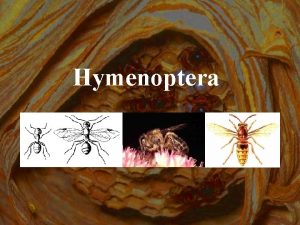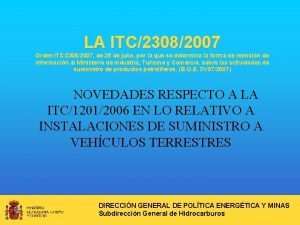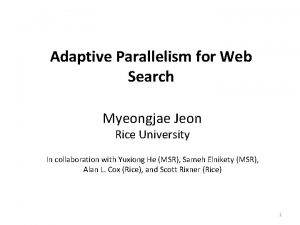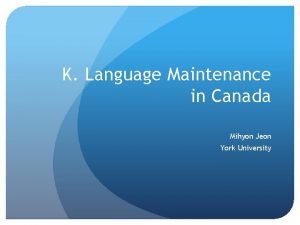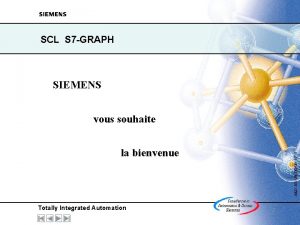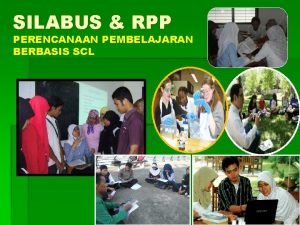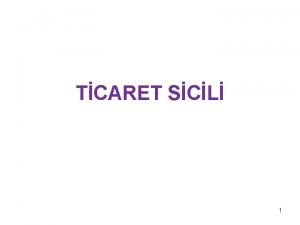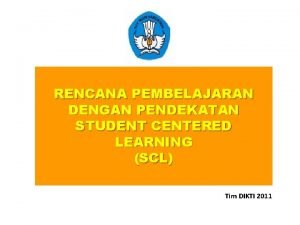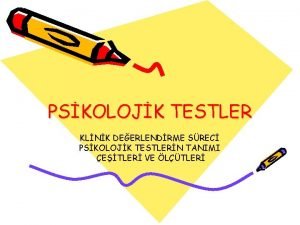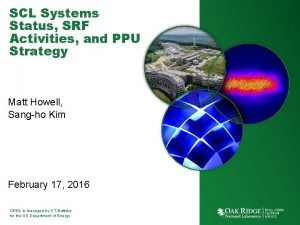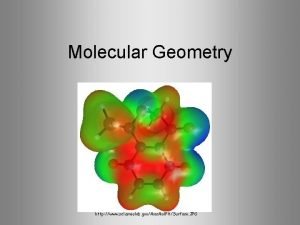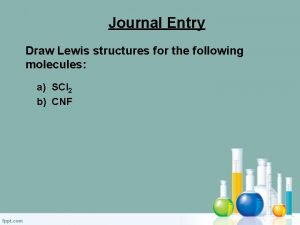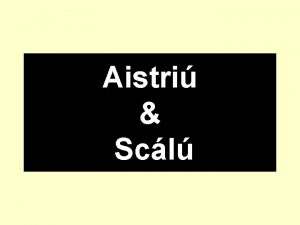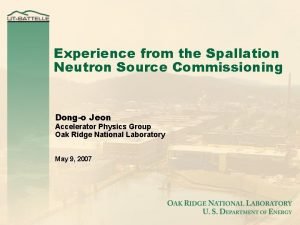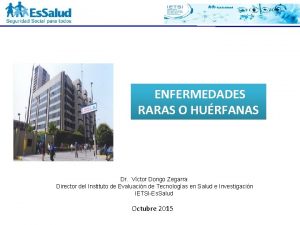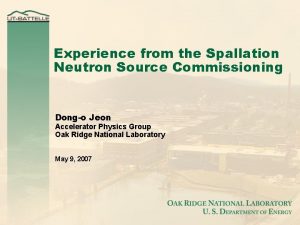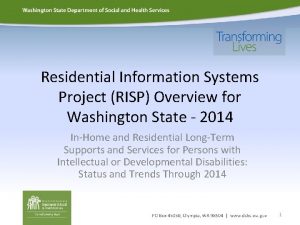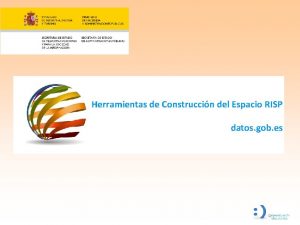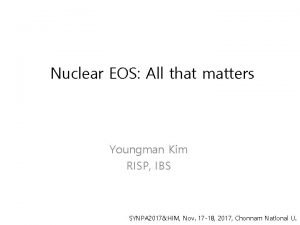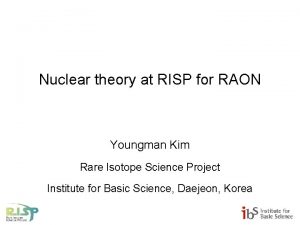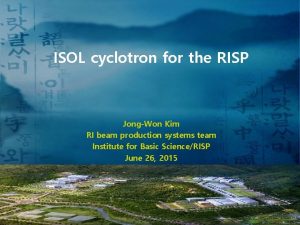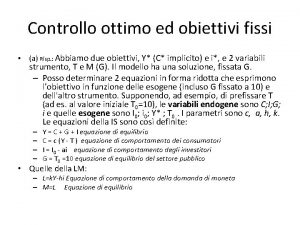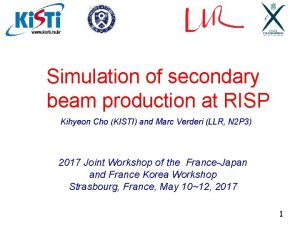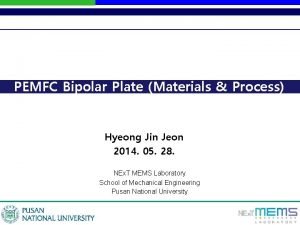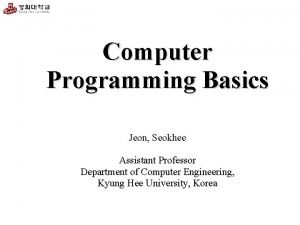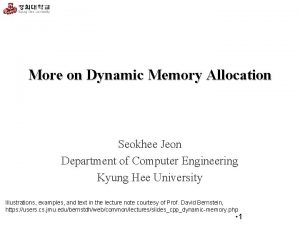RISP Overview of the RISP SCL DongO Jeon
































- Slides: 32

RISP Overview of the RISP SCL Dong-O Jeon representing the SCL Team Rare Isotope Science Project

Overview of the RISP IF Facility + ISOL Facility RISP

RF Frequency Choice RISP • Higher frequency generally means better efficiency. • No show-stoppers have been found for the choice of base frequency higher than 70 MHz considering design aspects including beam dynamics. • Broad infra base exists for 81. 25 MHz family (ANL, FNAL, TRIUMF, IMP. . . ) and 88 MHz family (SPIRAL 2, CERN, ESS, SARAF …). • Recommendation is made to choose between 81. 25 MHz and 88 MHz. • Decision is made to choose 81. 25 MHz as the RISP base frequency.

RISP Superconducting Linac Conceptual Design • Frequency choice is made : base frequency is 81. 25 MHz. • SC linac lattice is reviewed and alternative design is proposed with normal conducting quadrupoles. • Design of the charge stripping station is reviewed and alternative design is proposed. • Alternative charge stripping schemes are investigated and enough space is reserved in the lattice.

Choice of optimal geometric beta SSR 2 SSR 1 QWR HWR RISP: 0. 047, 0. 120, 0. 30, 0. 53 5 FRIB: 0. 041, 0. 085, 0. 29, 0. 53 For U beam RISP

Driver SC Linac Lattice RISP • Design to accelerate high intensity ion beams • Flexile operation to meet the needs of various user groups QWR SC cavity NC quadrupole beam box HWR 6 Previous Driver SCL with SC solenoids Driver SCL with NC doublets

Schematic drawing of the SCL 1 quadrupole RISP beam box Schematic drawing of the 1 segment quadrupole beam box Schematic drawing of the 2 segment beam box example (courtesy of SPIRAL 2)

Schematic drawing of the SCL 2 SSR 1 344 mm RISP quadrupole Schematic drawing of the 3 325 MHz segment SSR 2 486 mm Schematic drawing of the 4 325 MHz segment quadrupole

Driver SCL lattice change RISP SC solenoid lattice option has the following challenges : 1. Alignment of SC solenoids is not trivial to control. It is known that components in a cryomodule move no less than a millimeter during cool-down. 2. Small misalignment of SC solenoids by 0. 5 mm generates significant emittance growth for the previous design. 3. Heat deposit by beam loss in the SC solenoids can be an issue. 4. Operation of the SC Linac is not trivial for example due to magnetization of surrounding elements in the cryomodule.

Driver SCL lattice change RISP • NC quadrupole option has the following merits: 1. High intensity beam acceleration & operation are easy. 2. Linac cost seems to be in error range compared with the SC solenoid option. ( removal of costly SC solenoids ) 3. Accurate alignment of NC quadrupoles is feasible. 4. Preliminary cryo-load comparison suggests that overall cryo-load may not be an issue. difference is small compared with the dynamic load. 5. Better beam quality 6. Operation is more straightforward. • Linac length decrease : 97 m 90 m for the SCL 1, compared with the previous design.

ISOL post-accelerator RISP • For the ISOL SCL lattice, we are planning to share the same doublet lattice as the driver SCL to reduce cost and R&D efforts. • EBIS is considered rather than ECR IS, generating higher A/q beams. • Design optimized for A/q ≤ 4.

Cost of Doublet Lattice RISP • Cost estimation was done including cavity, tuner, coupler, internal cryogenics, vacuum system, cryomodule and process + cryomodule assembly cost. • Keeping the same lattice type for the driver SCL and ISOL SCL, cost estimation is done. • Cost change is less than 2% and is in error range of estimation. • Cost is not an issue.

Static cryo-load estimation of the SCL 1 RISP • TRIUMF type cryomodules (4 cav + 1 SC solenoid) 294 W @ 4 K (excluding SC solenoid cryo-load). • Proposed SCL lattice 372 W @ 4 K • Dynamic load is estimated to be 0. 81 k. W @ 2 K for the SCL 1. • Compared with dynamic load, the static load difference seems small.

RISP Comparison of doublet and solenoid lattice with the previous design Hyung Jin Kim Parameters Doublet Solenoid Comment Length [m] 90 97 Drift 50 cm in btwn cryomodules Input energy [Me. V] 0. 5 Energy [Me. V] 18. 5 # of cryomodule 59 15 # of quadrupole 118 - - 60 # of solenoid

RISP Beam Simulations xrms 4 ex yrms 4 ey DW/Wrms 4 ez Hyung Jin Kim

Phase advance in the SCL 1 RISP Hyung Jin Kim s/m s / period a

RISP Error specification Hyung Jin Kim Parameters SCRF Cavity Warm Quadrupole SC Solenoid Distribution Displacement (mm) 1 0. 15 0. 5 Uniform Rotation (mrad) - 5 - Uniform Phase (deg) 1 - - 3σ Gaussian Amplitude (%) 1 - - 3σ Gaussian

RISP Error simulations in β 1 section (baseline/solenoid) Hyung Jin Kim Max. envelope Centroid Emittance 76% increase 10% increase baseline 350% increase 130% increase solenoid The shade region represents the bounds of envelope, centroid and emittance due to misalignment and field errors. The aperture of quadrupole and solenoid is 2 cm.

QWR is being optimized 8 cm 77. 8 cm Matlabjon Sattorov 7. 68 cm 2 cm 18 cm 4 cm 8 cm 6 cm 22 cm RISP 2. 89 cm 11. 56 cm = 0. 047, f = 81. 25 MHz

QWR geometry & fields for f= 81. 25 MHz RISP Matlabjon Sattorov

Quantitative dependence of the design parameters RISP in % as a function of the geometry 30 20 10 0 -10 -20 -30 -40 -50 -60 120 E-peak B-peak R/Q Rs*Q 90 Change (%) Matlabjon Sattorov 60 30 0 -30 -60 20 30 40 50 60 70 80 90 90 100 95 Stem top radius r (mm) 120 100 0, 2 Change (%) 0, 4 100 105 110 115 Cavity outer radius R (mm) 0 -0, 2 -0, 4 50 0 -0, 6 -0, 8 -50 -1 -1, 2 150 -100 160 170 180 190 Cavity bottom height hb (mm) 200 60 70 80 Coax radius rs (mm) 90

HWR dimensions and Field plots 2 r d rdt rs h 2 r 1 g lint 2 R Eabs Habs RISP parameter value Frequency, MHz 162. 5 value 0. 12 Epeak, MV/m 30. 0 Bpeak, m. T 28. 2 R/Q, Ohm 132. 285 Gap voltage, MV 0. 595 Rs. Q, 41. 8138 r, mm 48. 5 R, mm 107. 8 d, mm 107. 7956 lint, mm 135. 5907 g, mm 34. 8975 rdt , mm 60 rs , mm 60 r 1 , mm 25 h, mm 936

Stripping Station Conceptual Design RISP • Change from 180º chicane to 90º bend. • Conforms better to the topography of the site. • Shorter in length better control in longitudinal plane. • Better in radiation activation control for the downstream section.

RISP Site Plan SCL

RISP Charge Selection with 180º Chicane Structure Chicane structure for charge selection (length: ~ 27 m) Charge selection slit Stripping foil Correction Sextupole 20º bending dipole Slit using TRANSPORT code Beam optics with off-momentum, Δp/p = 5% Q=79± 2 Vertical envelope Quad. Focusing Quad. Defocusing Horizontal dispersion Charge selection: • Minimum beta • Large dispersion Horizontal envelope Longitudinal position (2 m/div. ) Transverse position (4 cm/div. ) Transverse position (1 cm/div. ) Beam optics with on-momentum Dipole Quadrupole doublet Sextupole Without correction Aperture limitation (half: 10 cm) With sextupole correction Longitudinal position 25/19 (2 m/div. )

RISP Present Charge Stripping Section – 90° bend Hye-Jin Kim

Sufficient space reserved for liquid Li and/or Carbon strippers RISP

Charge Stripper RISP • Previously carbon foil was considered as the charge stripper. • We are designing the charge stripper section for liquid Li or He gas charge stripper. Courtesy of FRIB

Temp SCRF and Magnet Test Facility RISP • A contingency plan for the temporary Superconducting RF and Magnet Test Facility is being developed, considering a possible delay in procuring the site. • Plan and cost estimation are developed. • Cost is 2856 M KRW (= $2. 4 M) for SRF Facility and 1200 M KRW for Magnet Test Facility (20 m x 20 m)

Summary RISP • Base frequency of the SCL is determined. • For the SCL, NC quadrupole lattice is adopted rather than the SC solenoid lattice. • The SCL with NC quadrupole is better for beam quality control. • Cavity types and geometric betas are determined. • 90º charge stripper design is adopted. • Contingency plan for the Superconducting RF and Magnet Test Facility is developed.

Thanks for your attention! To the goal, Cheers!! RISP

RISP Beam envelope before and after stripper SCL to stripper Past stripper
 Gyakori lopódarázs
Gyakori lopódarázs Itc/2308/2007
Itc/2308/2007 Hejeon
Hejeon Myeongjae jeon
Myeongjae jeon Language maintenance
Language maintenance Graph siemens
Graph siemens Rpp metode scl
Rpp metode scl Scl ticaret
Scl ticaret Rpp berbasis scl
Rpp berbasis scl Scl-90 geçerlik güvenirlik
Scl-90 geçerlik güvenirlik Scl system
Scl system Scl nedir
Scl nedir Scl molecular geometry
Scl molecular geometry Nocl molecular shape
Nocl molecular shape Vẽ hình chiếu đứng bằng cạnh của vật thể
Vẽ hình chiếu đứng bằng cạnh của vật thể độ dài liên kết
độ dài liên kết Quá trình desamine hóa có thể tạo ra
Quá trình desamine hóa có thể tạo ra Môn thể thao bắt đầu bằng từ chạy
Môn thể thao bắt đầu bằng từ chạy Sự nuôi và dạy con của hổ
Sự nuôi và dạy con của hổ điện thế nghỉ
điện thế nghỉ Dot
Dot Thế nào là sự mỏi cơ
Thế nào là sự mỏi cơ Trời xanh đây là của chúng ta thể thơ
Trời xanh đây là của chúng ta thể thơ Voi kéo gỗ như thế nào
Voi kéo gỗ như thế nào Thiếu nhi thế giới liên hoan
Thiếu nhi thế giới liên hoan Fecboak
Fecboak Các châu lục và đại dương trên thế giới
Các châu lục và đại dương trên thế giới Một số thể thơ truyền thống
Một số thể thơ truyền thống Thế nào là hệ số cao nhất
Thế nào là hệ số cao nhất Ng-html
Ng-html Hệ hô hấp
Hệ hô hấp Tư thế ngồi viết
Tư thế ngồi viết Số nguyên tố là
Số nguyên tố là
